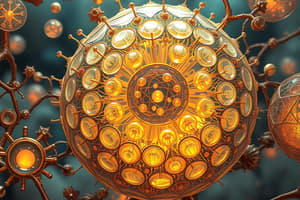Podcast
Questions and Answers
What is the function of the mitochondria?
What is the function of the mitochondria?
- Regulating the movement of molecules
- Transport of proteins and lipids
- Protein synthesis
- Producing energy in the form of ATP (correct)
Which organelle is referred to as the 'powerhouse' of the cell?
Which organelle is referred to as the 'powerhouse' of the cell?
- Nucleus
- Ribosomes
- Mitochondria (correct)
- Endoplasmic Reticulum (ER)
What is the main function of the endoplasmic reticulum (ER)?
What is the main function of the endoplasmic reticulum (ER)?
- Producing energy in the form of ATP
- Regulating the movement of molecules
- Protein synthesis
- Modification and transport of proteins and lipids (correct)
Which type of endoplasmic reticulum has ribosomes attached to its surface?
Which type of endoplasmic reticulum has ribosomes attached to its surface?
What is the role of ribosomes in a cell?
What is the role of ribosomes in a cell?
Which organelle contains the cell's genetic material?
Which organelle contains the cell's genetic material?
Which cell organelle is responsible for packaging proteins and lipids into vesicles?
Which cell organelle is responsible for packaging proteins and lipids into vesicles?
What is the function of lysosomes in a cell?
What is the function of lysosomes in a cell?
Which organelle is particularly prominent in plant cells and stores water, nutrients, and waste products?
Which organelle is particularly prominent in plant cells and stores water, nutrients, and waste products?
What is the composition of cytoplasm?
What is the composition of cytoplasm?
Which cell structure regulates the movement of molecules in and out of the cell?
Which cell structure regulates the movement of molecules in and out of the cell?
Why is understanding cell organelles and their functions crucial for understanding basic biology?
Why is understanding cell organelles and their functions crucial for understanding basic biology?
Flashcards are hidden until you start studying
Study Notes
Introduction
In the ninth grade, students learn about cells, which are the basic units of life. Cells are tiny, microscopic organisms that are responsible for all the activities of living organisms. They are composed of various cell organelles, which are specialized structures that carry out specific functions. In this article, we will explore the different cell organelles and their functions.
Cell Organelles
Nucleus
The nucleus is the control center of the cell. It contains the cell's genetic material, which is responsible for the cell's inherited traits. The nucleus is surrounded by a membrane called the nuclear envelope, which helps regulate the movement of molecules in and out of the nucleus.
Mitochondria
Mitochondria are responsible for producing energy in the form of ATP (adenosine triphosphate) through a process called cellular respiration. They are often referred to as the "powerhouse" of the cell.
Endoplasmic Reticulum (ER)
The ER is a network of tubules that is involved in the synthesis, modification, and transport of proteins and lipids. It is divided into two types: rough ER and smooth ER. Rough ER has ribosomes attached to its surface, while smooth ER does not.
Ribosomes
Ribosomes are responsible for protein synthesis, which is the process by which the cell produces proteins. They are composed of ribosomal RNA and proteins.
Golgi Apparatus
The Golgi apparatus processes, modifies, and sorts proteins and lipids that are produced by the ER. It is responsible for packaging these molecules into vesicles, which are then transported to their final destination in the cell.
Lysosomes
Lysosomes are membrane-bound organelles that contain digestive enzymes. They break down waste materials and cellular debris, helping to maintain the cell's internal environment.
Vacuoles
Vacuoles are membrane-bound organelles that store water, nutrients, and waste products. They are particularly prominent in plant cells.
Cytoplasm
The cytoplasm is the jelly-like substance that fills the cell and surrounds the nucleus. It is composed of water, salts, and dissolved nutrients and waste products.
Plasma Membrane
The plasma membrane is the outermost layer of the cell. It is a selectively permeable membrane that regulates the movement of molecules in and out of the cell.
Conclusion
In conclusion, cells are complex structures composed of various cell organelles, each with a specific function. Understanding these organelles and their functions is crucial for understanding the basic biology of living organisms. In the next article, we will delve deeper into the structure and function of these organelles.
Studying That Suits You
Use AI to generate personalized quizzes and flashcards to suit your learning preferences.




